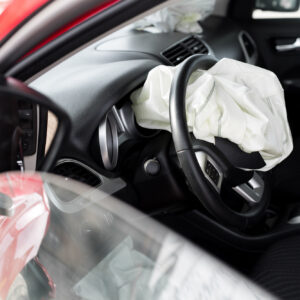Car air bags have saved many lives since their introduction in automobiles. However, they’re not perfect. If improperly used, air bags can cause injuries or fatalities, undermining their intended role in your vehicle. Fortunately, there are easy guidelines that can help you use the air bag correctly. Follow the air bag safety rules to maximize safety during collisions and road accidents.
Always Wear Your Seat Belt
Air bags aren’t the only safety features in your car or truck. Your vehicle usually has seat belts that secure the occupant to their seat. Modern vehicles have 3-point seatbelts in their front seats and some form of seat belts in their middle and rear seats.
Seat belts and air bags synergize together. The belt prevents you from getting thrown out of your seat while the bag slows you down and reduces the risk of hitting a hard surface at high speed.
When you get in your vehicle, always buckle up. Whether you’re the driver or a passenger, always wear your seat belt. Even collisions at relatively low speeds can hurl you out of your seat. While the air bag can slow you down, you might still go fast enough to get injured especially since the bag is rushing toward you. In the worst-case scenario, the air bag might fail to fully or properly deploy.
Keep a Minimum Distance From Air Bags
Air bags rapidly deploy, but they still take time to expand and require space for deployment. It’s recommended to stay a safe distance from the areas where the air bags are stored.
Maintain at least 10 inches of distance between your torso and the nearest surface. This rule applies to adults and children at least 12 years old.
If you’re in the driver’s seat, keep your distance from the steering wheel and the air bag in its central part. Move your seat toward the back while keeping your feet within easy reach of the brake and gas pedals. Furthermore, you must ensure your arms don’t bend or stretch when you grab the wheel. After all, maintaining firm control of your vehicle also contributes to your road safety.
If you occupy the front passenger seat, it’s the dash you must watch out for. The front passenger air bag usually emerges from a dash panel above the glove compartment. If you’re too close, there’s a low chance that the panel might hit you as the air bag pushes it away.
Slightly Recline the Back of the Seat
Instead of pushing your car seat backward to increase the distance between you and the steering wheel, you can recline the back of your seat. Lowering the seat’s back lets you lean away from the wheel and the front air bag.
Driving with a slightly reclined seat back will lower your head, potentially making it harder for you to see the road. You can resolve this issue by sitting on a non-slip seat cushion to raise your height while keeping the back of the seat leaning backward.
Adjust the Telescoping Steering Wheel
Some vehicles have a telescoping steering wheel that can tilt up or down. If your car or truck has an adjustable steering wheel, you can direct its air bag at your chest.
When you drive, tilt the telescoping steering wheel downward. The adjustment moves the air bar to your chest level instead of your face. If the air bag deploys, it will hit your chest, minimizing the risk of injury to your head or neck.
Children Under 12 Years Must Sit in the Rear Car Seats
While air bags save lives, they can also endanger children. Manufacturers design and test their air bag products with adults in mind. Unfortunately, children are smaller and more frail than adults, so they can get injured by rapidly expanding air bags.
This drawback also applies to seat belts. Most belts are for adults, so they might not tightly fit over children’s smaller bodies, increasing the risk that the kids might get injured.
Never put children younger than 12 years in the front passenger seat. Instead, have them sit in the middle or rear seat. Those seats don’t have air bags that might injure them.
Many areas require you to put your kid on a child safety seat or booster seat that can keep them secure while you drive.
Prioritize safety over speed whenever you drive with children aboard your vehicle. You’ll look over your shoulder to check on your kids, so it’s best to go slowly.
Learn more about child passenger safety with our helpful guide.
Get Familiar With Your Car’s Air Bags
Given how important air bags are, it’s highly recommended to get familiar with the ones in your car or truck. Modern vehicles usually have air bags for the front seats and other units elsewhere in the cabin.
If you intend to purchase an older or used vehicle, look up information about its air bags. You’ll want to know if the model’s old enough to lack air bags.
Ask the previous owner about the state of the vehicle’s air bags. Ensure the devices are working properly before committing to the purchase. Otherwise, you might have to replace the air bags.
Read the owner’s manual to learn about your vehicle’s air bags. The manual will usually show the locations of the safety devices and identify the air bags if you need to replace them.
Keep these simple air bag safety rules when you buy or drive a vehicle. They’ll provide the peace of mind and safety you deserve.
Where to Get Replacement Air Bag Sensors For Your Vehicle
While the air bag handles the job of cushioning impacts, it’s the air bag sensor that activates the safety device during a collision. If something goes wrong with the sensor, it can trigger the air bag at the wrong time–or never. Fortunately, CarParts.com offers reliable air bag sensors to replace faulty parts in your vehicle.
At CarParts.com, you’re assured of getting air bag sensors with long service lives and dependable performance. We exclusively source our products from some of the most reliable names in the automotive parts industry.
Our intuitive website makes finding an air bag sensor that fits your vehicle easy. Plug the year, make, model, and engine of your car or truck into our website’s built-in vehicle selector. You can tweak the results with the filters to find parts from specific brands or for certain locations.
Do you live in the continental US? Order a new air bag sensor from CarParts.com before noon ET and get it in as fast as two business days.
Any information provided on this Website is for informational purposes only and is not intended to replace consultation with a professional mechanic. The accuracy and timeliness of the information may change from the time of publication.



















